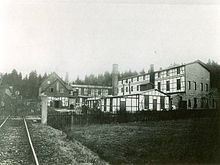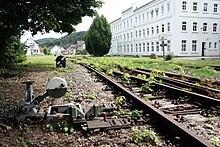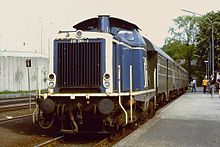Railway network in the Oberbergisches Land
The railway network in the Oberbergischer Kreis and the surrounding area consisted of a large number of individual routes. There was also a railway depot in Gummersbach - Dieringhausen, which was unusually large for a rural region . Of these routes, the Cologne-Kalk-Overath and Siegburg-Olpe routes operated by Deutsche Bahn (DB), both of which are also known as the Aggertalbahn , the Volmetalbahn , two sections of the former Cologne-Mülheim-Lindlar line and the Meinerzhagen route –Krummenerl in operation. The Wiehl Valley Railway between Osberghausen and Waldbröl is operated by a private railway for tourism and goods traffic and is to be expanded by the Wissertal Railway , but there are no specific plans yet. The other routes are now fully or partially dismantled.
history


The railway age in Oberbergischen began in 1860 with the granting of a concession for the construction of a narrow-gauge horse-drawn railway, the Bröltalbahn from Hennef to Waldbröl . The Bröltalbahn was the first narrow-gauge public transport railway in Germany. As early as 1863, the operation was switched to steam locomotive traffic. With the branch lines Aggertalbahn and Volmetalbahn , the remote region got its first standard-gauge railway lines. For a long time a main railway line Cologne - Kassel planned through the region, which was never realized. Instead, the longer routes in the Oberbergisches Land were created as branch lines to reduce construction costs. A network of smaller, often private railways developed around it, mostly to develop rural industry. There was a large regional depot at Dieringhausen station to supply the routes. Dieringhausen was the most important train station (4 platform tracks) in the region until the 1970s . Unusually for a rural region, there was an interurban tram in Gummersbach . The Dieringhausen depot, closed in 1982, became the private Dieringhausen Railway Museum.
Among other things, the simple design as branch lines provided the reason for the closure of the lines from the 1950s . Savings by the Federal Railroad and a decline in the number of passengers and goods volumes led to rationalization and shutdowns. Gradually the passenger traffic was stopped, later the freight traffic . Only the Wuppertal Railway was shut down for another reason: at least officially because of the construction of the Wuppertalsperre , on whose territory it partially ran.
Today the Oberbergisches Land has been free of scheduled freight traffic of the Deutsche Bahn since 1997 ( Wiehltalbahn ). Only consumer goods traffic on the Wiehl Valley Railway reestablished itself after the turn of the millennium.
Most of the Oberbergisches Land is now completely without rail connections.
The entire length of the rail connection from Cologne to Hagen was reactivated for passenger traffic.
Operated routes

- The Volmetalbahn between Bruges and Meinerzhagen has been in service again as scheduled since December 2017. It is used every hour between Hagen and Lüdenscheid by the regional train Volmetal-Bahn (RB 52) . The Oberbergische Bahn (RB 25) operates on the southern section between Dieringhausen and Bruges . The section between Gummersbach and Marienheide, which has been used again since 2003, and since February 27, 2014 also to Meinerzhagen station , is so far the only route in the region that has been reactivated for public transport after the wave of closures in the 1970s / 1980s . In December 2017, the section from Meinerzhagen to Lüdenscheid train station was reactivated.
- The Cologne-Kalk-Overath railway and the rest of the Siegburg-Olpe railway are used by the Oberbergische Bahn (RB 25), which runs from Cologne Hansaring to Dieringhausen and from there on the Volmetalbahn to Meinerzhagen. For the CityBahn project on the Cologne – Meinerzhagen line, ten class 218 locomotives and n-wagons repainted in pop colors in pure orange with a pebble gray belly band were used as push-pull trains in regular service. These train sets represent a special feature in railway history, as they were only used on the Aggertalbahn and then in regular service in the S-Bahn advance service.
- The sections Cologne - Bergisch Gladbach and Rösrath - Hoffnungsthal (today part of the Aggertalbahn) of the Cologne-Mülheim-Lindlar railway line . The former is used by the S 11 , the section from Rösrath to Hoffnungsthal is now part of the Aggertalbahn, on which the Oberbergische Bahn operates. On the route to Bergisch Gladbach there is also freight traffic to a paper factory at the old branch to Bensberg. The western part, which is still used today, does not belong to the region dealt with here.
- The Wiehltalbahn has been used for tourism and consumer goods traffic from Dieringhausen and Osberghausen to Remperg / Mühlenau since 1998 . During construction, it was mainly used to develop the quarries and industry in the Wiehl valley. It lost its passenger service in 1965. Until its closure in 1994, Deutsche Bahn still operated freight services. A club took over the route. The Wiehltalbahn with all buildings is a listed building. The dispute that broke out between 2006 and 2008 over the reactivation attracted nationwide attention. Since April 18, 2010 the Wiehltalbahn with the name Bergischer Löwe has been running back to Waldbröl. The purpose of the association is initially tourism, but the main goal is to resume local public transport. The Waldbröl City Council decided on February 15, 2012 to propose the reactivation of the Wiehl Valley Railway to upgrade it to the new local transport plan in North Rhine-Westphalia. In view of the fact that the Wiehl Valley Railway, along with the section from Marienheide to Bruges, is the only line in the Oberberg area that is still fully suitable for reactivation after all other railway lines in the area have been closed and wholly or partially dismantled, this represents a turning point in terms of transport policy of the region.
- The guy Valley Railway is navigated back of work vehicles of Wiehltal workers after extensive cut-work, since October of 2009. It consisted of two railway lines. The first line built led from Morsbach to Wissen (Sieg) , the second from Hermesdorf on the Wiehltalbahn to Morsbach. There both lines merged in a terminal station, the only one in the region. The section from Volperhausen nach Wissen was badly damaged in the Second World War and was not restored. From Volperhausen to Morsbach there was passenger traffic until 1954 and freight traffic until 1960, after which this remaining section was also closed and dismantled. The section from Hermesdorf to Morsbach lost passenger traffic at the same time as the Wiehl Valley Railway in 1965, until 1994 Deutsche Bahn still operated residual goods traffic, but the track systems had been in a very poor condition in recent years. Today, this stretch between Hermesdorf and Morsbach is being repaired by the Wiehl valley railroaders , so that it will be reactivated for the museum trains in a few years . There are still no precise public plans for reactivation. Like the Wiehltalbahn, the Wissertalbahn and all structures are under monument protection.
- The Meinerzhagen – Krummenerl railway north of the Oberbergischer Kreis should actually continue to Olpe . However, this project was no longer completed. So it has always been just a branch line to this day, and passenger traffic was discontinued in 1955. However, it is still used daily in freight transport.
Disused and dismantled routes
- The Siegburg – Olpe line in the Siegburg - Overath section (Luhmer Grietche) has been dismantled between Lohmar and Overath. There are still remains between Siegburg and Lohmar. In 1956 passenger traffic was ended, in 1962 the entire Lohmar-Overath line was taken out of service and demolished in the same year. In 1988 goods traffic between Siegburg-Siegwerk and Lohmar was discontinued (1993 shutdown). The Siegburg - Siegburg-Siegwerk section is still used for freight traffic.
- Passenger traffic on the Siegburg – Olpe railway line in the historic eastern section between Dieringhausen and Olpe has been shut down since 1979. Freight traffic followed gradually until 1997. Today the route is interrupted by numerous buildings, some structures have already been demolished. At the time of the two world wars and the occupation of the Ruhr , this section, together with the Wiehl Valley Railway, was historically important as a diversion route for coal trains and other important transports. There are plans for a cycle path for almost the entire section.
- The railway line Brüchermühle - Wildbergerhütte (also called Hütter Bahn ) was a branch line of the Wiehl Valley Railway, which was closed in 1953 for passenger traffic and 1959 for goods traffic. It was originally intended to be extended to the Finnentrop – Freudenberg railway line , but this no longer happened. So it was dismantled in 1960, the Oberbergische route with the shortest life and can only be seen in a few remains.
- The Leppetalbahn ( Engelskirchen - Marienheide) was a narrow-gauge small railway that was mainly used for freight traffic. It was shut down for passenger traffic in 1949 and for freight traffic in 1958 and can only be guessed at from the former route.
- The Cologne-Mülheim – Lindlar railway line (popularly: Sülztalbahn, Cologne - Bergisch Gladbach - Bensberg - Rösrath - Hoffnungsthal - Lindlar ) has been dismantled from Bergisch Gladbach-Heidkamp via Bensberg to Rösrath and from Hoffnungsthal to Lindlar. Passenger and freight traffic were shut down in the 1960s. For the part traveled, see under operated routes .
- The Bielstein – Waldbröl Kleinbahn branched off from the Wiehltalbahn in standard gauge. It connected villages in the Bröltal and was mainly built for industry. In 1957 passenger traffic was stopped, in 1966 goods traffic. The demolition of the line began just a week later. Today the remanufactured Waldbröl steam locomotive , which was in service here and on the Wiehl Valley Railway, still reminds of the route.

- The Gummersbacher Kleinbahnen were an electrified freight and tram in standard gauge that ran from the Gummersbach city center via Niederseßmar and Derschlag to Dümmlinghausen . It was the only electrified line in the region and was created because the railway line from Siegburg to Olpe between Vollmerhausen and Derschlag was relocated to the slope and the old tracks on the road became free. It was shut down in the early 1950s and replaced by a trolleybus line that had existed for nine years . This was replaced by omnibuses. Today only remains exist in the form of a railway embankment on the Agger in Dümmlinghausen and two railway bridges (one at the Vereinshaus stop, the other behind the “Holländer Diele” restaurant) in Derschlag. A tram car is exhibited in the Dieringhausen Railway Museum.
- The Wippertalbahn was a standard-gauge, non-electrified railway line from Remscheid-Lennep station via Bergisch Born, Hückeswagen and Wipperfürth to Marienheide. In 1985, goods and passenger traffic between Wipperfürth-Ost and Marienheide ceased. In 1986 passenger traffic followed for the remaining section. Until 1995 there was still freight traffic between Bergisch Born and Wipperfürth. Most of the route has been dismantled today.
- The Wuppertal Railway from Oberbarmen via Radevormwald , stop , Halver to Oberbrügge or Wipperfürth to stop was mostly single-track and not electrified. One of the biggest rail accidents in post-war German history occurred on it in 1971. (→ Miscellaneous ). It was gradually shut down from the 1950s and the rest in the 1980s as part of the construction of the Wuppertal Dam and the savings made by the Deutsche Bundesbahn. Today it is only used on a few sections (outside of the Oberbergischen), partly in museum railway operation. The eastern section from Oberbrügge to Halver still exists as a Schleifkottenbahn and is to be reactivated for freight traffic or a possible light rail system by Schleifkottenbahn GmbH .
- The Bröltalbahn (from Waldbröl to Hennef) was the first public narrow-gauge railway in Germany and part of a larger private railway network south of Waldbröl. It was shut down for passenger traffic in 1956. The last freight train ran in 1967. Today only a few buildings and vehicles can be seen of the route.
- There were also some small industrial railways that have not yet been described here.
Regular passenger traffic
- Oberbergische Bahn (RB 25) on the so-called Aggertalbahn and Volmetalbahn from Cologne to Meinerzhagen
- Volmetal Railway (RB 52) on the northern Volmetal Railway from Hagen to Lüdenscheid
- Museum railway traffic on the Wiehl Valley Railway
Railway Museum
In the Dieringhausen Railway Museum (formerly Bw Dieringhausen) a. Aspects of regional and national transport history are highlighted in special exhibitions. The museum is open on weekends and bank holidays. The railway museum is the starting point of the museum train rides on the Wiehltalbahn with the steam train of the railway museum and the MAN rail bus (stored in the museum) of the support group for the rescue of the Wiehltalbahn eV
Special
- The reception building of the former Hützemert train station is today, besides the Olpe train station, the only listed relic on the entire Bergneustadt - Olpe section and also the only remaining train station between Derschlag and Olpe since the Wiedenest train station was demolished in 1973 and Bergneustadt train station in 2009 . The only remaining stop on this section is Pernze . Most of the tracks are removed between Derschlag and Olpe.
- The viaduct of the Sülztalbahn has been without tracks since 1965, but is still accessible. A few years ago, the owner of Linde station, who had since died, was supposed to integrate it into an island operation for a museum railway. However, for reasons of cost, this did not materialize.
- Near Immekeppel, almost 50 years after its closure, large parts of the embankment still exist.
- In Lindlar the water tower of the Sülztalbahn is still standing near the old reception building. Today the water tower is in a better optical condition than when it was in operation.
- The only surviving relic of the Bielstein – Waldbröl Kleinbahn , the Waldbröl steam locomotive , was restored in the Dieringhausen Railway Museum until 2009 and is now pulling museum trains on the Wiehl Valley Railway, and rarely special trains on other routes.
- The city viaduct in Drolshagen shaped the townscape for over 100 years before it was demolished in 2009.
Others
- The Dahlerau train accident was one of the worst rail accidents in Germany after the Second World War. On May 27, 1971, two trains collided on the Wuppertal Railway in the Radevormwald district of Dahlerau. 46 passengers died, 41 of whom were students at the Radevormwalder Geschwister-Scholl-Schule.
- The train of remembrance stopped in Oberbergischen on the Wiehl Valley Railway, which is otherwise only used for tourism and goods traffic, in Wiehl station (March 7–8, 2008).
- The railway operations on the eastern part of the Aggertalbahn and the connecting Finnentrop – Freudenberg and Asdorftalbahn lines can be re- enacted in an extension for the Microsoft Train Simulator from the 1960s / 1970s.
- There were two unusual train runs on the Oberbergische routes. One of them drove as a daily pair of trains for almost 70 years from Wuppertal via the Wippertalbahn, Aggertalbahn and Wiehltalbahn to Waldbröl, and after the closure of the Wiehl valley railway to Dieringhausen until 1979. The other, even more unusual route was a hedge cable train from Cologne via the Aggertalbahn to Olpe and on via Finnentrop-Wennemen to Paderborn (Kardinalsexpress) , which operated in the 1960s until the Finnentrop-Wennemen railway was closed .
literature
- Sascha Koch, Horst Kowalski u. a .: Railways in Oberberg and the history of the Dieringhausen depot . Galunder Verlag, Nümbrecht 2005, ISBN 3-89909-050-0 .
- Eisenbahnfreunde Remscheid eV: Railways in the Bergisches Land - A photo documentation . Galunder Verlag, Nümbrecht 2006, ISBN 3-89909-070-5 .
- Eisenbahnfreunde Remscheid eV: Railways in the Bergisches Land II - A photo documentation . Galunder Verlag, Nümbrecht 2009, ISBN 978-3-89909-090-1 .
- Axel Johanßen: From the embankment to the parking lot - train impressions yesterday and today from the Rhineland. Galunder Verlag, Nümbrecht 2007, ISBN 978-3-89909-080-2 .
- Rainer Gries, Herbert Nicke: The Wiehltalbahn and its importance as a monument to the regional economy . Galunder Verlag, 2002, ISBN 3-931251-99-3 .
- Sascha Koch: Dieringhausen - Bergneustadt - Olpe - Chronicle of a railway line between the Rhineland and Westphalia . Galunder Verlag, 2003, ISBN 3-89909-019-5 .
- Gerhard Peter Hänsel: Step by step . The railways in the Sülztal and Aggertal. A regional historical investigation. (= Series of publications of the history association Rösrath eV Volume 15 = 86, 1). History association for the community of Rösrath and the surrounding area, Rösrath 1986, ISBN 3-922413-21-3 .
- Bernd Franco Hoffmann: The Sülztalbahn. History and stories of the Cologne-Bergisch Gladbach-Rösrath-Untereschbach-Immekeppel-Lindlar route. (= Series of publications of the history association Rösrath eV Volume 42). 2012, ISBN 978-3-922413-65-3 .
- Bernd Franco Hoffmann: Disused routes in the Bergisches Land. Sutton-Verlag, 2013, ISBN 978-3-95400-147-7 .
See also
- List of local rail transport lines in North Rhine-Westphalia
- List of railways in North Rhine-Westphalia until 1930
Web links
- bahnen-wuppertal.de
- Oberbergische Railways
- Wiehltalbahn
- There is no train going anywhere: the Dieringhausen-Bergneustadt-Olpe route . ( Memento from June 29, 2011 in the Internet Archive ) In: Die Modellbahnwoche .
Individual evidence
- ↑ Commissioning of the reactivated railway line from Meinerzhagen to Lüdenscheid – Bruges planned for the end of 2017. NWL, February 17, 2015, accessed on February 17, 2015 (press release).







